Kenneth Morton was just 21 when he sailed into Napier’s harbour aboard the Halcione in September 1878.
He must have been made of stern stuff because in March the following year Kenneth made the four-day journey by horse from Napier to Katikati to visit his brother Berkeley.
He’d arrived in Katikati in 1878 as part of George Vesey Stewart’s second party of settlers – to become the only planned Ulster Irish settlement worldwide. Orena Betty started her own Aonga Prefix stud and exported semen from one of her top bulls to the UK. Their son Craig began a Kaimai stud, and all studs were combined to form Morton Shorthorns in 1996. “Some of our customers have so much trust in our stock they buy bulls and heifers sight unseen,” says Craig. Historical photos courtesy of the Katikati Archives.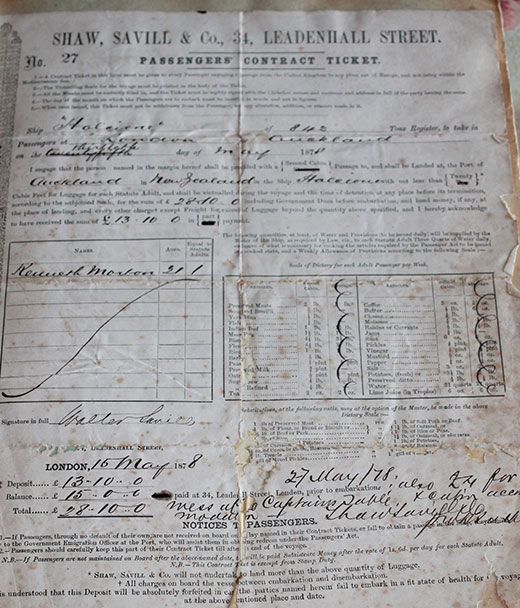
Kenneth Morton’s ticket to sail on the Halcione cost 28 pound 10 shillings in 1878.
As a single man Kenneth didn’t qualify to join the settlers brought out by Stewart but nonetheless in 1883 he purchased the first of 700 acres of land at Aongatete, not far from Katikati, and began a tradition of farming and community leadership which continues among his descendants, who 131 years on still farm the land he bought.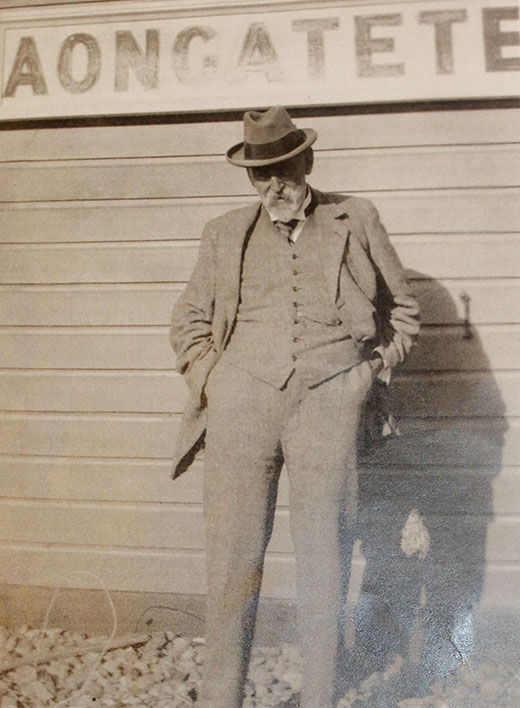
Kenneth Morton, at the Aongatete Railway Station in the early 1900s.
His grandson Ken Morton and great grandson Craig, who farm at Aongatete, are proud of Kenneth’s achievements and those of his son Tom.
In 1884 when the Katikati Cheese and Bacon factory opened, Kenneth was on the board of directors and after his marriage in 1890 to Josephine Mulvany. The couple made their own ‘Orena” cheese. When the Katikati dairy factory opened in 1902, they supplied it with milk from their pedigree Orena Shorthorn Stud.
Kenneth was a foundation member of the Tauranga A&P Show and as well as exhibiting at the first Katikati A&P Show in 1913, held the position of president for many years.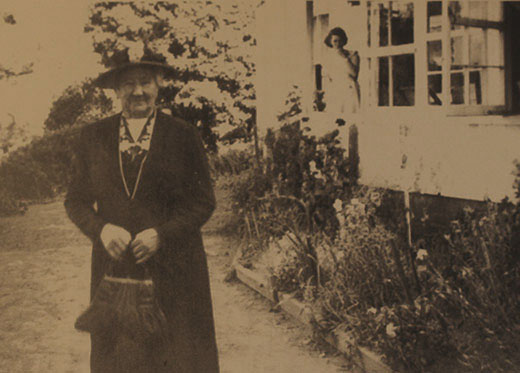
Josephine Morton was the matriarch of the Katikati pioneer farming family.
Kenneth and Josephine’s only son Tom attended No 3 School in Walker Rd, walking or riding a horse there. In those days all supplies for the district arrived by steamer in Tauranga, from Auckland, and were transported by smaller craft to Katikati because the roads were virtually non-existent. The Morton family drove stock for sale over Thompsons Track into the Waikato, an arduous trip, with animals often getting stuck in a big bog hole near the summit.
Tom served in the Middle East with the Driscoll Scouts in World War 1 and was a member of the Legion of Frontiersmen, being made a life member in 1985. He and his wife Grace (nee Tetley) eventually took over the family farm and Tom gained a reputation for breeding prize-winning Clydesdale horses. However, much of the original holding was sold to settle the inheritance of his five sisters.
Tom and Grace Morton feature in the Katikati Mural ‘Our People, Our Story’ which recognises their roles with the local A&P society.
Tom’s son Ken and wife Betty were the next to farm the land, and Ken established Orena Shorthorn Stud in the late 1960s, raising animals for beef rather than dairy as in his grandfather’s day.
Ken, like his grandfather, has been president of the Katikati A&P Show, and today Craig holds the position. Both Craig and Ken have played, and continue to play, important roles with the New Zealand Shorthorn Association, with Craig set to become its president this year.
Ken and Betty live on the family farm in Morton Rd but its day-to-day management is carried out by Craig, who lives with his wife Maree on a nearby farm in Works Rd – bought by his father 50 years ago.
Shorthorn
Despite the trend in the district of cutting up land for lifestyle blocks or growing kiwifruit, Ken says he’s never been tempted to change from drystock farming.
“I’ve never considered dairy farming either,” says the committed shorthorn breeder.
“Shorthorn were the first cattle to arrive in New Zealand 200 years ago, but they are not such a well-known breed today,” says Ken, who admires the animals for their temperament, confirmation and meat they produce. But it’s more than that which keeps him and Betty involved with shorthorns.
“It’s the people we have met through breeding shorthorns – we have friends all over the world and shorthorn breeders are really nice, genuine people.”
Ken, Betty and Craig and Maree, have built a reputation for not only producing fine examples of the Shorthorn breed, but also for integrity as breeders.
“If something goes wrong with an animal we’ve sold, and sometimes it does, we put it right.”
Morton Shorthorn has 45 breeding cows and its bulls have won the champion title at the National Bull Sale eight times. In 1995 Orena Super Rattler sold for $21,000 and Morton bulls have made $9000 and $10,000 in sales too.
Bulls
“Part of our success has been that we have imported semen from overseas to introduce new bloodlines,” says Craig. Next year’s bulls will be the progeny of a top Australian bull, which sold at auction for $46,000.
“When we are looking for bulls to buy semen from, we look at their pH levels [which affects the eating quality of beef], the amount of fat, growth rates and fertility.
“Meat with a certain amount of fat tastes and cooks better and we aim for calves with a higher than average birth weight – around 4.3kg – as they will grow quicker than smaller calves.”
Craig says with only about 45 shorthorn breeders in New Zealand, there are fewer resources to promote the breed in the way that Hereford and Angus breeds have been able to achieve.
In contrast, shorthorns are highly regarded in Britain with breeders there entering agreements with supermarkets. “I think something similar needs to happen in New Zealand,” says Craig.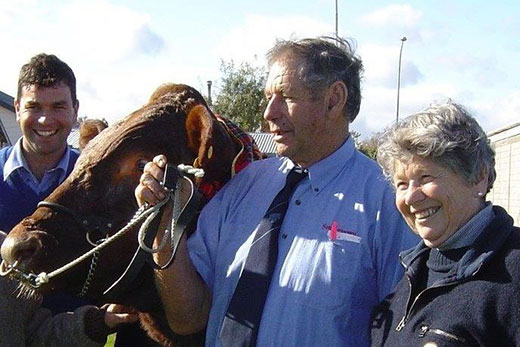
Craig Morton and his parents Ken and Betty with the bull they bred called Orena Super Rattler that sold in 1995 for $21,000.
Lamb
Craig and Maree also farm 700 ewes and recently formed a relationship with an Auckland restaurant, supplying lambs on a regular basis. Maree also sells lamb and mutton at the Tauranga Farmers Market and the Katikati market. “We have repeat customers who just love how the meat tastes because it is top quality and so fresh.” Craig thinks this is a model for beef farmers to follow too.
“Increasingly, consumers want to know where their food comes from, who produced it, and what inputs were used. We are not organic but use organic fertiliser on the Works Rd farm and animals are drenched only when necessary.”
Craig says one of the strengths of farming in the Katikati district is the service and support received from local businesses. He and Ken value their relationships with Aldridge Contracting, which makes bales 400 conventional bales on the farm annually.
Shorthorn stud farming isn’t the way to get rich, and the Morton family could have made more money by diversifying into horticulture, dairying or subdivision – but that’s never been the agenda for Ken.
“Once you sell land like this, you never get it back again,” says Ken.
The Morton farm is in a prime location on the shores of the Tauranga Harbour – and Ken and Craig believe the unique lifestyle it affords of farming and fishing is likely to endure for future generations.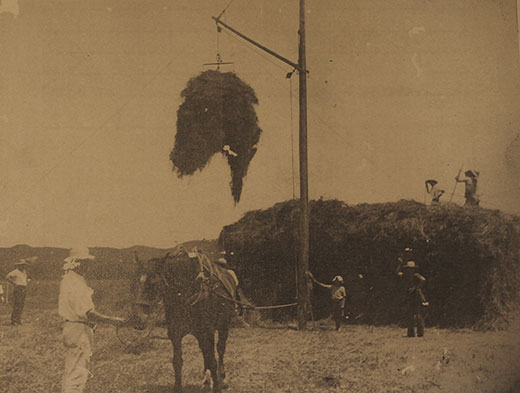
Haymaking was labour-intensive on the Morton farm in the early 1900s.


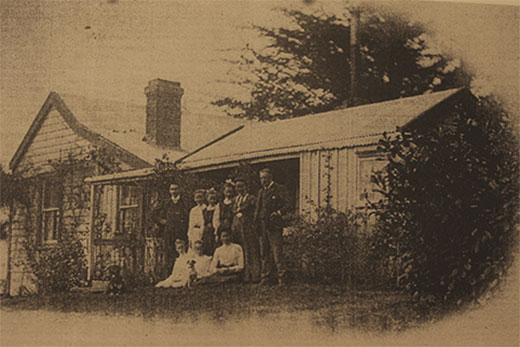
0 Comments
Leave a Comment